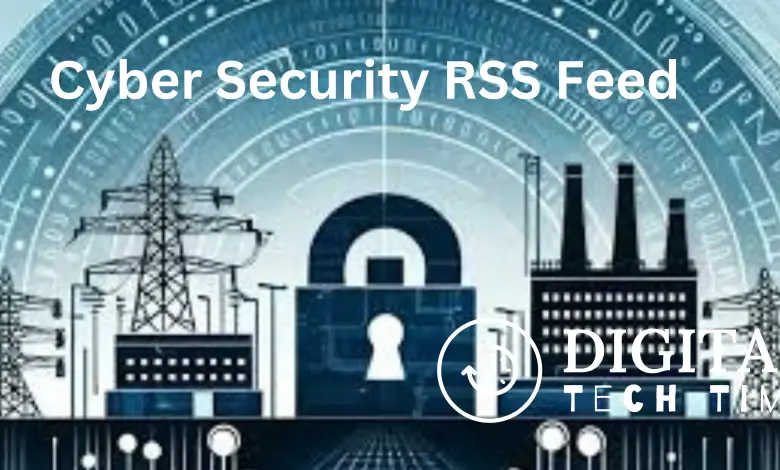Cyber Security RSS Feed: Stay Up-to-Date with the Latest Threats and Solutions

Cybersecurity is an ever-evolving field, and keeping up with the latest developments can be a challenge for security professionals. Cyber Security RSS Feeds are an excellent way to stay informed about the latest news, trends, and threats in the cybersecurity world. RSS feeds are a type of web feed that allows users to access updates from multiple sources in a single location.
By subscribing to Cyber Security RSS Feeds, security professionals can get real-time updates on the latest security vulnerabilities, malware threats, and data breaches. This helps them stay informed about the latest security threats and take proactive measures to protect their organizations from these threats. In addition, Cyber Security RSS Feeds can also provide valuable insights into emerging trends and best practices in the cybersecurity world.
Key Takeaways
- Cyber Security RSS Feeds are an excellent way to stay informed about the latest news, trends, and threats in the cybersecurity world.
- By subscribing to Cyber Security RSS Feeds, security professionals can get real-time updates on the latest security vulnerabilities, malware threats, and data breaches.
- Cyber Security RSS Feeds can also provide valuable insights into emerging trends and best practices in the cybersecurity world.
Understanding Cyber Security Rss Feed
Cyber Security RSS Feeds are a means of delivering the latest news and information on cybersecurity to subscribers. RSS stands for Really Simple Syndication, which is a web-based technology that allows publishers to distribute content to readers in a standardized format. The content is then delivered to the subscriber’s RSS reader, which can be a standalone application or a web-based service.
Cyber Security RSS Feeds are an effective way to stay up-to-date with the latest cybersecurity news and trends. They are particularly useful for cybersecurity professionals who need to stay informed about the latest threats and vulnerabilities. By subscribing to Cyber Security RSS Feeds, professionals can receive real-time updates on the latest cybersecurity threats, vulnerabilities, and best practices.
There are many Cyber Security RSS Feeds available, and they cover a wide range of topics related to cybersecurity. Some of the most popular Cyber Security RSS Feeds include The Hacker News, NIST RSS Feeds, and the NCSC RSS Feeds. These feeds provide a wealth of information on topics such as cybersecurity news, threat intelligence, vulnerability assessments, and best practices.
Cyber Security RSS Feeds are also an excellent resource for individuals and small businesses who are looking to improve their cybersecurity posture. By subscribing to Cyber Security RSS Feeds, individuals and small businesses can stay informed about the latest cybersecurity threats and best practices. This information can help them take proactive steps to protect their personal and business data from cyber threats.
Overall, Cyber Security RSS Feeds are an essential tool for anyone who wants to stay informed about the latest cybersecurity news and trends. By subscribing to Cyber Security RSS Feeds, individuals and businesses can stay ahead of the curve and take proactive steps to protect themselves from cyber threats.
Importance of Cyber Security Rss Feed
Cybersecurity is a critical concern for businesses, organizations, and individuals alike. With the increasing frequency and sophistication of cyber attacks, it is essential to stay up-to-date with the latest developments in the field. One way to do this is by subscribing to Cyber Security RSS Feeds.
RSS Feeds allow users to receive updates from multiple sources in one place. This means that instead of having to visit each website individually, users can receive updates from all their favorite sources in one central location. This saves time and ensures that users do not miss any important news or developments.
Cyber Security RSS Feeds are particularly important because they provide real-time updates on the latest threats and vulnerabilities. This means that users can stay informed about the latest security risks and take proactive measures to protect themselves and their organizations. For example, if a new malware strain is discovered, a Cyber Security RSS Feed can provide immediate information on how to detect and remove it.
Another benefit of Cyber Security RSS Feeds is that they allow users to customize the information they receive. Users can choose which sources to subscribe to and can filter the information they receive based on their specific interests and needs. This means that users can receive information that is tailored to their individual needs, making it easier to stay informed and up-to-date.
In summary, Cyber Security RSS Feeds are an essential tool for anyone interested in staying informed about the latest developments in the field. They provide real-time updates on the latest threats and vulnerabilities, allow users to customize the information they receive, and save time by centralizing updates from multiple sources. By subscribing to Cyber Security RSS Feeds, users can stay ahead of the curve and take proactive measures to protect themselves and their organizations.
Types of Cyber Security Rss Feeds
Cyber security RSS feeds are a great way to stay up-to-date on the latest cyber security news and threats. There are several types of cyber security RSS feeds available, each with its own unique focus and purpose.
Threat Intelligence Feeds
Threat intelligence feeds provide information about the latest cyber threats and attacks. They are typically updated in real-time and include information about the type of attack, the target, and any known vulnerabilities that were exploited. Threat intelligence feeds are an essential tool for cyber security professionals who need to stay informed about the latest threats and take action to protect their networks.
Vulnerability Feeds
Vulnerability feeds provide information about the latest software vulnerabilities and patches. They are typically updated on a regular basis and include information about the severity of the vulnerability, the affected software, and any available patches or workarounds. Vulnerability feeds are an essential tool for IT professionals who need to stay informed about the latest security patches and updates.
Incident Reports Feeds
Incident reports feeds provide information about the latest cyber security incidents and breaches. They are typically updated on a regular basis and include information about the nature of the incident, the affected organization, and any known impact on customers or users. Incident reports feeds are an essential tool for cyber security professionals who need to stay informed about the latest threats and take action to protect their networks.
In conclusion, cyber security RSS feeds are a valuable resource for anyone who needs to stay informed about the latest cyber threats and attacks. By subscribing to the right feeds, you can stay up-to-date on the latest security patches, vulnerabilities, and incidents, and take action to protect your network from potential threats.
How to Use Cyber Security Rss Feed
Cyber Security RSS feeds are a great way to stay up-to-date with the latest news and trends in the cybersecurity industry. Here are a few steps to help you get started with using Cyber Security RSS feeds:
- Choose a reliable RSS reader: To subscribe to Cyber Security RSS feeds, you need an RSS reader. There are many options available, including Feedly, Inoreader, and NewsBlur. Choose one that suits your needs and preferences.
- Find Cyber Security RSS feeds to subscribe to: There are many Cyber Security RSS feeds available online. You can use search engines to find them or check out the top Cyber Security RSS feeds lists available on websites such as Feedspot or Cyber Security Hub.
- Subscribe to Cyber Security RSS feeds: Once you have found Cyber Security RSS feeds that interest you, subscribe to them using your RSS reader. Most RSS readers have a search function that you can use to find and subscribe to feeds. Alternatively, you can copy and paste the feed URL into your RSS reader.
- Organize your Cyber Security RSS feeds: To make it easier to read and manage your Cyber Security RSS feeds, organize them into folders or categories in your RSS reader. For example, you can create folders for news, blogs, podcasts, and social media feeds.
- Stay up-to-date with Cyber Security RSS feeds: Check your RSS reader regularly to stay up-to-date with the latest Cyber Security news and trends. You can also set up alerts in your RSS reader to notify you of new content from your favorite Cyber Security RSS feeds.
By following these steps, you can use Cyber Security RSS feeds to stay informed about the latest developments in the cybersecurity industry.
Choosing the Right Cyber Security Rss Feed
When it comes to selecting a Cyber Security RSS feed, there are a few criteria that one should consider. By taking these factors into account, individuals can ensure that they are receiving relevant and up-to-date information on the latest cyber threats and security measures.
Criteria for Selection
The following are some important factors to consider when selecting a Cyber Security RSS feed:
- Relevance: The feed should provide information that is relevant to the individual’s area of interest or expertise. For example, a feed that focuses on healthcare security may not be as useful for someone who works in the financial industry.
- Frequency: The feed should be updated frequently enough to provide timely information. Daily or weekly updates are ideal.
- Accuracy: The feed should provide accurate and reliable information. It should be from a reputable source and not contain false or misleading information.
- Ease of Use: The feed should be easy to read and navigate. It should be accessible on various devices and platforms.
Recommended Providers
There are many Cyber Security RSS feeds available, but not all of them are created equal. Here are a few recommended providers:
- The Hacker News: This feed provides up-to-date news and analysis on the latest cyber threats and security measures. It is updated daily and covers a wide range of topics.
- Dark Reading: This feed is aimed at IT professionals and covers topics such as data breaches, malware, and cybercrime. It is updated daily and provides in-depth analysis and commentary.
- KrebsOnSecurity: This feed is run by journalist Brian Krebs and provides in-depth reporting on cybercrime and security issues. It is updated several times a week and is known for its investigative journalism.
- Threatpost: This feed provides news and analysis on the latest cyber threats and security measures. It is updated daily and covers a wide range of topics, from ransomware to IoT security.
By considering the criteria for selection and choosing a reputable provider, individuals can ensure that they are receiving timely and accurate information on the latest cyber threats and security measures.
Challenges in Cyber Security Rss Feed
While Cyber Security RSS feeds can be an excellent source of information, there are some challenges that users may face. Some of the challenges are:
1. Information Overload
With so many Cyber Security RSS feeds available, it can be challenging to keep up with all the information. Users may find themselves overwhelmed with the sheer volume of content, making it difficult to identify the most relevant and useful information.
2. Inaccurate or Outdated Information
Not all Cyber Security RSS feeds are created equal. Some may provide inaccurate or outdated information, which can be misleading and potentially harmful. Users must be careful to verify the information they receive and ensure that it is from a reliable source.
3. Cybersecurity Risks
Cyber Security RSS feeds can also pose a risk to users if they are not careful. Malicious actors may use RSS feeds to distribute malware or phishing scams, which can compromise a user’s security. Users must be cautious when subscribing to RSS feeds and ensure that they are from a trustworthy source.
4. RSS Feed Management
Managing multiple RSS feeds can be challenging, especially for users who subscribe to a large number of feeds. Users must stay organized and prioritize the most important feeds to ensure that they do not miss critical information.
Overall, while Cyber Security RSS feeds can be an excellent source of information, users must be aware of the challenges they may face. By staying organized, verifying information, and being cautious, users can effectively leverage RSS feeds to stay up to date on the latest Cyber Security news and trends.
Future of Cyber Security Rss Feed
As the world becomes increasingly digitized, cyber threats continue to evolve and become more sophisticated. Cybersecurity experts predict that the future of Cyber Security RSS feeds will be focused on providing real-time threat intelligence, automated analysis, and customized alerts to organizations.
One major trend in the future of Cyber Security RSS feeds is the use of machine learning and artificial intelligence to analyze large volumes of data and identify potential threats. This technology will enable organizations to detect and respond to cyber threats in real-time, reducing the risk of data breaches and other cyber attacks.
Another trend in the future of Cyber Security RSS feeds is the use of customized alerts. Organizations will be able to tailor their RSS feeds to their specific needs and receive alerts on the types of threats that are most relevant to their business. This will enable organizations to respond quickly to cyber threats and minimize the impact of potential breaches.
In addition, Cyber Security RSS feeds will become more integrated with other security tools and platforms, such as Security Information and Event Management (SIEM) systems. This integration will enable organizations to streamline their security operations and respond more quickly to cyber threats.
Overall, the future of Cyber Security RSS feeds looks promising, with new technologies and trends emerging to help organizations stay ahead of the evolving cyber threat landscape. As cyber threats continue to evolve, it is essential for organizations to stay up-to-date with the latest security trends and technologies to protect their assets and data.
Frequently Asked Questions
What are some reliable sources for Cyber Security RSS feeds?
There are several reliable sources for Cyber Security RSS feeds. Some of the most popular ones include the National Institute of Standards and Technology (NIST) RSS feeds, the National Security Agency/Central Security Service (NSA/CSS) Activity Feed, and the U.S. Department of Defense RSS feeds. These sources provide timely and accurate information on Cyber Security threats, vulnerabilities, and best practices.
Which are the best InfoSec blogs to follow for Cyber Security updates?
There are many excellent InfoSec blogs that provide Cyber Security updates on a regular basis. Some of the best ones include KrebsOnSecurity, Dark Reading, Threatpost, and SecurityWeek. These blogs cover a wide range of topics related to Cyber Security, including data breaches, malware, phishing, and ransomware.
How can I subscribe to the CISA RSS feed for Cyber Security alerts?
To subscribe to the Cybersecurity and Infrastructure Security Agency (CISA) RSS feed for Cyber Security alerts, simply visit the CISA website and click on the RSS icon located in the upper right-hand corner of the page. This will take you to the CISA RSS feed page, where you can subscribe to the feed using your preferred RSS reader.
What are some popular Cyber Security RSS feeds?
Some of the most popular Cyber Security RSS feeds include the NIST RSS feeds, the NSA/CSS Activity Feed, the U.S. Department of Defense RSS feeds, the CISA RSS feed for Cyber Security alerts, and the SANS Internet Storm Center RSS feed. These feeds provide valuable information on Cyber Security threats, vulnerabilities, and best practices.
How can I stay updated on Cyber Security threats through RSS feeds?
To stay updated on Cyber Security threats through RSS feeds, it is important to subscribe to reliable sources that provide timely and accurate information. Some of the best sources include government agencies like NIST, NSA/CSS, and CISA, as well as InfoSec blogs like KrebsOnSecurity, Dark Reading, Threatpost, and SecurityWeek. By subscribing to these feeds, you can stay informed about the latest Cyber Security threats and take steps to protect your organization.
Are RSS feeds a secure way to receive Cyber Security updates?
RSS feeds can be a secure way to receive Cyber Security updates, as long as you subscribe to reliable sources and take steps to secure your RSS reader. It is important to use a reputable RSS reader that encrypts your feed subscriptions and does not store your login credentials in plain text. Additionally, you should avoid clicking on suspicious links or downloading files from unknown sources, as these can lead to malware infections and other security issues.





